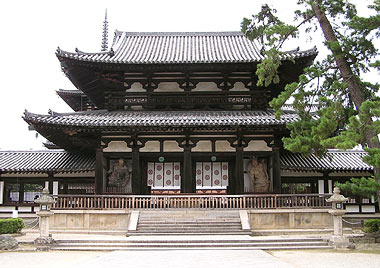|
||
 |
||

Houryuuji Chuumon @²å (Nara)
2@In an aristocratic dwelling shinden Qa, of the Heian period, the gates partway along the corridors *chuumonrou åL, connecting the residential quarters tai-no-ya ÎÌ®, and the fishing or fountain pavilions tsuridono Þa or izumidono òa. See *shinden-zukuri Qa¢.
3@The gate dividing the outer tea garden *sotoroji OIn, and the inner tea garden *uchiroji àIn, of a teahouse. The chuumon serves as a symbol to mark the boundary between the relatively profane world of the outer garden and the pure "wilderness" of the inner garden. It is also the spot where the host of the tea gathering usually meets his guests. Compared to the outer gate at the entrance to the *roji In, the chuumon is light in construction, usually with a roof made of cogrongrass, cypress bark, bamboo, or *yamatobuki åa (the technique in which boards are placed in two rows vertical to the ridge of the roof). In addition to wood and splint doors, there are bamboo lattice doors takekoushido |iqË, and wicker doors ajirido ÔãË. The gate posts are typically logs and the entire structure is of the *udegimon rØå (roof and bracket gate) type. Several of the trump stones *yaku-ishi ðÎ, such as the guest's stone *kyaku-ishi qÎ, host's stone teishu-ishi àåÎ, and the step-over stone *norigoe-ishi æzÎ, are placed on either side of the chuumon. In some cases, the under-the-door stone tozuri-ishi Ë Î, is placed beneath the gate door. Sometimes the straddling gate or *nakakuguri ö replaces the chuumon. The use of chuumon in roji is associated with the design of Kobori Enshuu ¬xB (1579-1647).
@
(C)2001 Japanese Architecture and Art Net Users System.@No reproduction or republication without written permission.
fÚÌeLXgEÊ^ECXgÈÇASÄÌRec̳f¡»E]ÚðֶܷB

